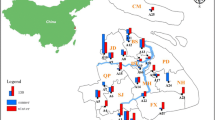Abstract
Background, aim, and scope
The aim of the study was to identify the impact of polychlorinated dibenzo-p-dioxin and furan (PCDD/F) emission sources on ambient air concentrations in the Malopolska Region, southern Poland. Three sites were selected: the city center of Krakow (Aleje), an industrial area (Nova Huta), and a rural site (Zakopane). In order to investigate the annual variations of PCDD/F sources, summer and winter time samples were taken.
Materials and methods
Ambient air particulate matter (PM10) was collected using an Anderson High-Volume sampler during June and December 2002 in the three mentioned sites. Analysis of PCDD/Fs was based on isotope dilution using high-resolution gas chromatography–high-resolution mass spectrometry for quantification.
Results and discussion
Total concentrations of 2,3,7,8-PCDD/Fs in air particulate phase from Malopolska region ranged from 0.6 to 37 pg m−3 (0.04–3.2 pg WHO98-TEQ per cubic meter, 0.037–2.9 pg I-TEQ per cubic meter). Higher PCDD/F concentrations were measured at all three sites during winter. A linear correlation among PCDD/F concentrations, benzo(a)pyrene (B(a)P) and PM10 concentrations, was found in Aleje and Zakopane, which suggested that all compounds were originating from the same source, solid fuel domestic heating. Instead, PCDD/F levels in Nova Huta did not correlate with the seasonality of B(a)P or PM10 levels and 2,3,7,8-PCDD/F congener patterns for this site were significantly different from the other sites.
Conclusions
Domestic solid fuel combustion is likely the main PCDD/F source in winter in this part of Poland for urban and rural sites. PCDD/F fingerprints in the industrial site remained almost identical during summer and winter, confirming the yearly prevalence of the emissions from the nearby metal industry.
Recommendations and perspectives
PCDD/F concentrations found in Malopolska Region are in the upper range of ambient air concentrations of PCDD/Fs reported worldwide. However, further research is needed in order to study the impact of the deposition of these PCDD/F emissions on the region. A more extended study is being conducted in the area to analyze soil samples, such as sink of atmospheric deposition, and spruce needles, as indicator of PCDD/F availability.



Similar content being viewed by others
References
Abad E, Saulo J, Caixach J, Rivera J (2000) Evaluation of a new automated cleanup system for the analysis of polychlorinated dibenzo-p-dioxins and dibenzofurans in environmental samples. J Chromatogr A 893(6):838–391
Brzuzy LP, Hites RA (1996) Global mass balance for polychlorinated dibenzo-p-dioxins and dibenzofurans. Environ Sci Technol 30:1797–1804
Christoph EH, Eisenreich SJ, Mariani G, Paradiž B, Umlauf G (2005) PCDD/Fs in ambient air of Krakow: seasonal changes in congener distributions. Organohalogen Compounds 67:1205–1209
Christoph EH, Eisenreich SJ, Ghiani M, Mariani G, Mueller A, Niedzialek J, Paradiz B, Skejo H, Umlauf G (2006) Levels and patterns of PCDD/Fs in air, soil and biota from Krakow and the Malopolska Region (Poland). Organohalogen Compounds 68:1029–1033
Cleverly D, Ferrario J, Byrne C, Riggs K, Joseph D, Hartford P (2007) A general indication of the contemporary background levels of PCDDs, PCDFs, and coplanar PCBs in the ambient air over rural and remote areas of the United States. Environ Sci Technol 41(5):1537–1544
Correa O, Rifai H, Raun L, Suarez M, Koening L (2004) Concentrations and vapor-particle partitioning of polychlorinated dibenzo-p-dioxins and dibenzofurans in ambient air of Houston, TX. Atmospheric Environ 38:6687–6699
De Assuncao J, Pesquero CR, Bruns RE, Carvalho LRF (2005) Dioxins and furans in the atmosphere of Sao Paulo City, Brazil. Chemosphere 58:1391–1398
Eurostat (2007) Energy: yearly statistics 2005. Eurostat Statistical Books, 476 pp
Grochowalski A (1998) PCDDs and PCDFs concentration in combustion gases and bottom ash from incineration of hospital wastes in Poland. Chemosphere 9–12:2279–2291
Grochowalski A, Chrzgszcz R (1997) PCDD/Fs in suspended particulate matter in ambient air from Krakow City, Poland. Organohalogen Compounds 32:76–80
Grochowalski A, Lassen C, Holtzer M, Sadowski M, Hudyma T (2007) Determination of PCDDs, PCDFs, PCBs and HCB emissions from the metallurgical sector in Poland. Environ Sci Pollut Res 14(5):326–332
Hagenmaier H, Lindig C, She J (1994) Correlation of environmental occurrence of polychlorinated dibenzo-p-dioxins and dibenzofurans with possible sources. Chemosphere 29:2163–2174
Harrad SJ, Jones KC (1992) A source inventory and budget for chlorinated dioxins and furans in the United Kingdom environment. Sci Total Environ 126:89–107
Lohmann R, Harner T, Thomas GO, Jones KC (2000) A comparative study of the gas-particle partitioning of PCDD/Fs, PCBs, and PAHs. Environ Sci Technol 34:4943–4951
Moche W, Thanner G (2002) Emission von Dioxinen, PCBs and PAHs aus Kleinfeuerungen, Federal Environment Agency—Austria, Monographien-Band 153
Paradiž B, Dilara P, Horak J, De Santi G, Christoph EH, Umlauf G (2008) An integrated approach to assess the PCDD/F emissions of the coal fired stoves combining emission measurements and ambient air levels modeling. Chemosphere 73:S94–S100
Quass U, Fermann M, Bröker G (2004) The European dioxin air emission inventory: project and results. Chemosphere 54:1319–1327
Schecter A, Birnbaum L, Ryan J, Constable J (2006) Dioxins: an overview. Environ Res 101:419–428
Smith LM, Stalling DL, Johnson L (1984) Determination of part-per-trillion levels of polychlorinated dibenzofurans and dioxins in environmental samples. Anal Chem 56(11):1830–1842
van den Berg M, Birnbaum L, Bosveld ATC, Brunstrom B, Cook P, Feeley M et al (1998) Toxic equivalency factors (TEFs) for PCBs, PCDD, PCDFs for humans and wildlife. Environ Health Perspect 106:775–792
Yu L, Mai B, Meng X, Bi X, Sheng G, Fu J, Peng P (2006) Particle-bound polychlorinated dibenzo-p-dioxins and dibenzofurans in the atmosphere of Guangzhou, China. Atmospheric Environ 40:96–108
Acknowledgements
We would like to thank Malopolski Voivodship (Inspectorate for Environmental Protection) for the providing the PM10 filters and B(a)P data; Kristina Kubica and Jiri Horak for providing the soot sample. In addition, we acknowledge Helle Skejo (IES-EC JRC) for assistance in the analyses and Anne Mueller (IES-EC JRC) for helpful discussions.
Author information
Authors and Affiliations
Corresponding author
Rights and permissions
About this article
Cite this article
Umlauf, G., Christoph, E.H., Eisenreich, S.J. et al. Seasonality of PCDD/Fs in the ambient air of Malopolska Region, southern Poland. Environ Sci Pollut Res 17, 462–469 (2010). https://doi.org/10.1007/s11356-009-0215-4
Received:
Accepted:
Published:
Issue Date:
DOI: https://doi.org/10.1007/s11356-009-0215-4




